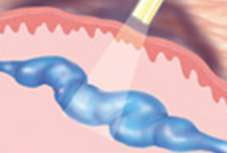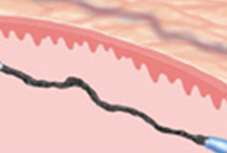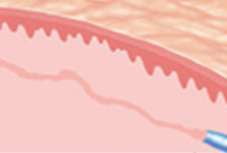Laser Treatment for Spider Veins
Telangiectasias, commonly known as Spider veins, are usually tiny dilated blood vessels beneath the skin surface and calibrated between 0.5 & 1 millimeter in dimension. They might take place wherever on the body, nevertheless are normally observed around the nasal area, cheeks & chin. They may also appear on the lower limbs exclusively on the top of the legs, usually just below the knee joint in addition to throughout the ankles. Problems can occur when the valves inside the blood vessels behave faulty.
Dimed spider vein removal machine is based on the thermal action of the laser. The transcutaneous irradiation (with a penetration of 1 to 2 mm in the tissue) causes tissue selective absorption by hemoglobin (hemoglobin is the main target of the laser). 940nm/532nm laser is the optimum absorption spectrum of Porphyrin vascular cells. Vascular cells absorb the high-energy laser of 940nm/ 532nm wavelength, solidification occurs and finally dissipates.

(1) During Treatment
Non-invasive laser energy is absorbed by hemoglobin and converted to heat energy.

(2) Immediately after Treatment
Blood Coagulates and the vessel wall collapses.

(3) After Treatment
Over time the vessel is reabsorbed by the body and disappears.
The laser of our spider vein or thread vein removal machine can stimulate dermal collagen growth while vascular treatment, increases epidermal thickness and density so that the small blood vessels are no longer exposed, at the same time, the skin’s elasticity and resistance are also significantly enhanced.
High absorption 532nm treatments are preferred for smaller and more superficial vessels. Superficial and small-diameter vessels are most selectively treated with wavelengths that are strongly absorbed by oxyhemoglobin as the vessels can be heated to clinical response temperatures with minimal incident energy. However, high oxyhemoglobin absorption can limit the depth to which laser light penetrates the skin, making it difficult to treat large or deep vessels with these wavelengths.
Moderate absorption 940nm treatments are preferred for larger and deeper vessels. Less strongly absorbed wavelengths penetrate more deeply, and can more uniformly heat through larger diameter vessels. Higher fluences are used to overcome the lower absorption coefficient and successful treatments can be achieved with good selectivity. Of the near-infrared wavelengths, 940nm is optimal since it has the highest oxyhemoglobin absorption coefficient for improved selectivity, reduced discomfort, and fewer side effects.
Clinical Applications of Laser Vein Removal
- Vascular Lesions
- Telangiectasia (spider veins)
- Spider Angiomas (radiating spider veins)
- Cherry Angiomas (red dots)
- Neovascularization (redness in new scars)
- Venous Lakes (blue spider veins)
- Rosacea (adult acne and flushing)
- Port Wine Stains (red birthmarks)
Clinical Advantages of Laser Treatment
- Complete: pulsed laser can penetrate deep into the skin’s vascular tissue, stimulate the laser beam to be absorbed by hemoglobin, let hemoglobin solidify, make vascular tissue closed, and completely achieve perfect spider vein removal.
- No scars: 940nm/532nm laser can intelligently identify skin lesions, there isn’t any impact on the normal skin tissue during the whole treatment, it is non-invasive physical therapy, there will be no cut on the skin, combines with proper post-long care, will almost no scarring.
- Fast and easy: only twenty minutes can finish one treatment
- Immediate result: After the 940nm/532nm laser treatment, large blood vessels will become smaller and lighter, and smaller vessels will disappear directly, the treatment effect is very significant.


